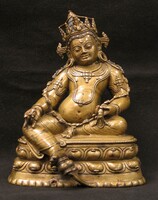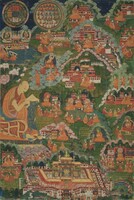
Bodhisattva, heroic aspirant to enlightenment, idealized beings in the appearance of youthful and beautiful heavenly gods, richly attired in silk-like garments and jewels. Bodhisattvas can be male or female and represent the principal realized students of Shakyamuni Buddha, Amitabha Buddha and others, according to the Mahayana Sutras of Northern Buddhism. There are many bodhisattvas mentioned in the Sutras but the most famous and most commonly represented in art are the Eight Great Bodhisattvas. (See the full definition of the term Bodhisattva).
Eight Great Bodhisattva:
Akashagarbha: Womb of Space Sutra, others
Avalokiteshvara: Heart Sutra, Lotus of the Good Law Sutra, others
Kshitigarbha: Earth Store Sutra
Maitreya: mentioned in the Pali Sutras as the next buddha, Mahayana Sutras
Manjushri: Vimalakirti-nirdesha Sutra, Flower Garland Sutra, Prajnaparamita Sutras
Nivarana-vishkhambhin
Samantabhadra: Lotus of the Good Law Sutra, Flower Garland Sutra
Vajrapani: Early Sutras
In 10th-13th century India there were several praises (stotra) composed by scholars and devotees glorifying the deeds of their favourite bodhisattva from Sutra literature. Tibetan tradition follows these various praises with four bodhisattva in particular being regarded as the most important; Manjushri, Avalokiteshvara, Vajrapani and Maitreya.
Depictions of the eight bodhisattva are non-iconic and follow the artistic traditions of the time, art school, or choices of the artist. Non-iconic means they do not have fixed body colours, postures or hand attributes. Later traditions began to mix Tantric iconography with the non-iconic imagery of the Mahayana Sutra Bodhisattva. For example Manjushri would be depicted as orange in colour and holding a sword in a variety of relaxed postures. Avalokiteshvara would be white in colour and holding a white lotus flower.
The first three bodhisattva also came to hold important positions in the early Tantras of the Kriya Classification and as a group are called the Three Lords of the Families, or Three Bodhisattva Lords (Tibetan: rig sum gon po). In this role the three take on fixed iconographic appearances as described in the specific Tantra literature.
Sets Of Eight Great Bodhisattvas:
- Set 1 (Mongolian Pantheon)
- Set 2 (Roerich Museum)
- Set 3 (300 Icons)
- Group of Sets 4 (Palpung Composition re-constructed set)
- Group of Sets 5 (Kham, Tibet)



















